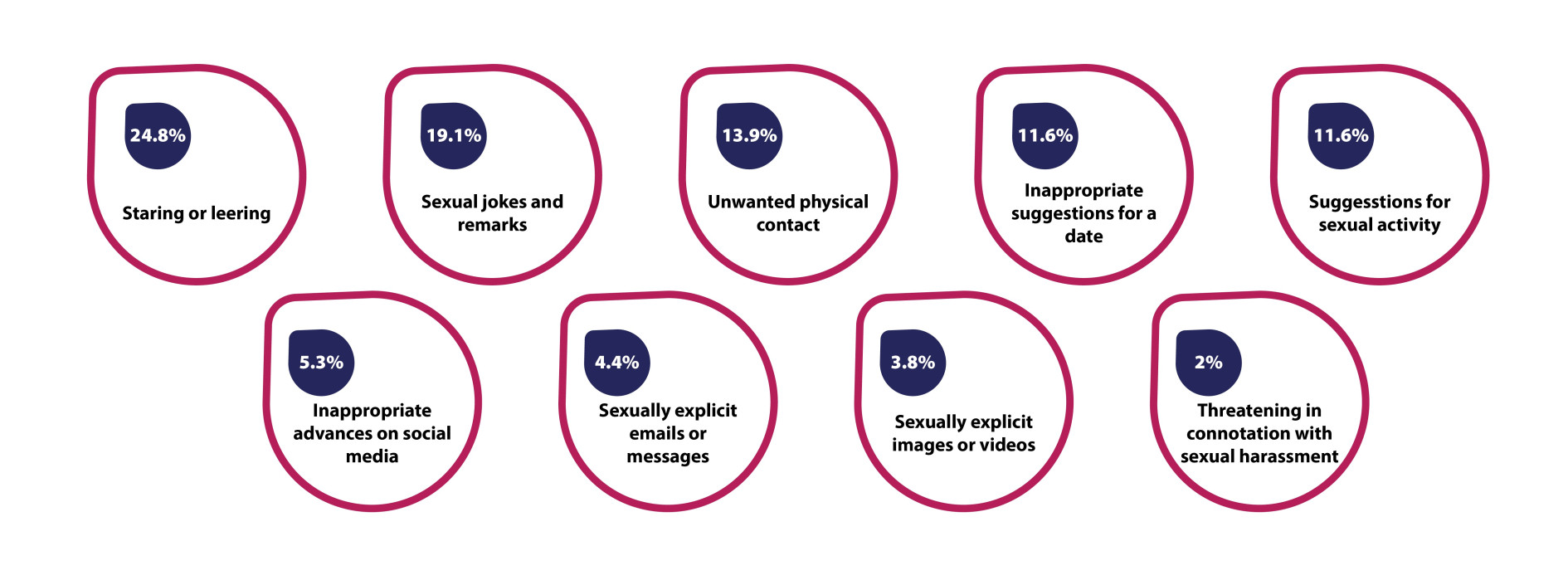Almost 1 in 3 women have experienced sexual harassment at work in their lifetime, with 18 % facing it multiple times.
Yet 75 % of women think that workplace sexual harassment is not common.
What is sexual harassment?
"Where any form of unwanted verbal, non-verbal or physical conduct of a sexual nature occurs, with the purpose or effect of violating the dignity of a person, in particular when creating an intimidating, hostile, degrading, humiliating or offensive environment."
EU Directive 2002/73/EC
Sexual harassment at work is a gender equality issue
Sexual harassment at work mainly affects women. Although it is a workplace problem, sexual harassment is primarily a gender issue driven by those men who feel entitled to sexualise women through touching, inappropriate advances on social media, emails or texts, sexual jokes, or exposure to sexually explicit images. These unwanted behaviours harm the victims' dignity and create a toxic work environment.
Women experience sexual harassment mostly from men, with colleagues being the common offenders.
Men also experience sexual harassment at work (SHW). Throughout the 11 Member States for which the EU GBV Survey collected data also on violence against men, results show a lower prevalence of SHW compared to women.
Sexual harassment can take many forms
Across the EU, rates of sexual harassment women experience at work vary widely: from 55 % in Sweden, 54 % in Finland, 53 % in Slovakia and go as low as 12 % in Portugal and Bulgaria, and 11 % in Latvia.
As part of the EU gender-based violence survey, women shared their experiences of sexual harassment, selecting from a list of acts that made them feel offended, humiliated or intimidated:
- Inappropriate staring or leering
- Indecent sexual jokes or offensive remarks about their body or private life
- Unsolicited physical contact e.g. close proximity, touching body parts, kisses/ hugs or something else that they did not want
- Inappropriate suggestions to go out on a date
- Inappropriate suggestions for any sexual activity
- Inappropriate advances on social networking websites
- Inappropriate sexually explicit emails or text messages
- Exposure to sexually explicit images
- Threats with unpleasant consequences if they refused sexual proposals or advances

Young women are at a high risk of sexual harassment
The survey reveals a concerning reality: some groups of women face a significantly higher risk of sexual harassment than others.
The high prevalence among young women indicates that experiencing sexual harassment has become a part of their daily lives.
Sexual harassment at work also happens online - including through workplace tools and social media
This is not surprising, as sexual harassment at work often happens behind closed doors, during business trips, and increasingly online, through direct communication.
In fact, 7 % of women who experiences sexual harassment at work reported that it involved the use of online tools.
Urgent need for targeted actions
Findings highlight the urgent need for targeted actions that acknowledge sexual harassment at work as a gender issue, recognise the unique vulnerabilities faced by young women, and address the online dimension.
Stronger protection and more accessible support systems are needed to prevent gender-based violence and harassment in the workplace. We must prioritise the voices and experiences of women, in particular young women, ensuring safer environments where their rights are respected and upheld.
Preventing and addressing sexual harassment at work start with committing to a culture of zero tolerance
EIGE and the EU Fundamental Rights Agency are working together to raise awareness on the scale and features of sexual harassment at work in the EU.
A resource package presenting the key findings from the survey is now available to help employers reinforce their commitment to a zero-tolerance culture.
HR personnel, line managers, trade union representatives, D&I officers, and other interested parties, can download these resources and use them to raise awareness.
The resource package includes the following assets and here is how each can help
- ‘Zero tolerance to sexual harassment at work’ poster - organisations are encouraged to display it in their office, use in their internal communication and share it on their social media.
- Slide deck - presents the features of sexual harassment at work across all EU Member States, helping to understand how widespread and underreported it is. Employers can drive change by acknowledging the scale and the gendered nature of sexual harassment at work, and by taking a firm stand against it.
- Messages and visuals – ready-to-use materials that organisations can use to communicate their commitment to a zero-tolerance culture.


